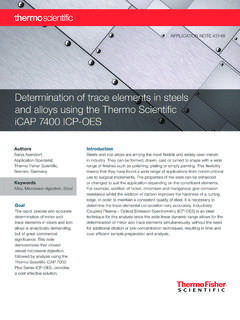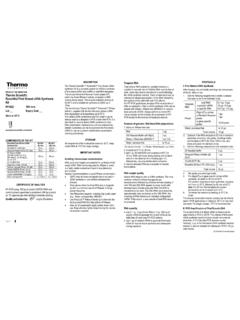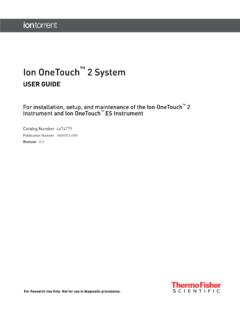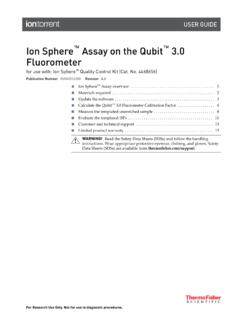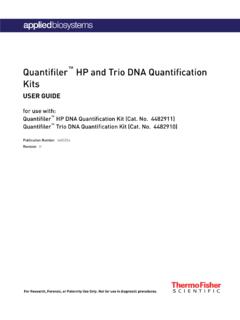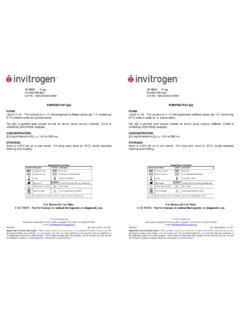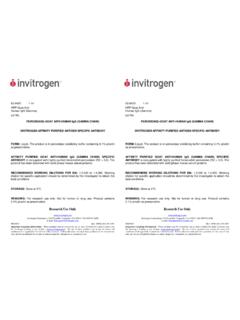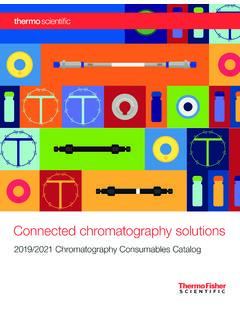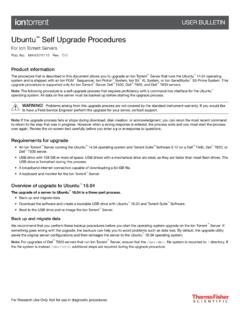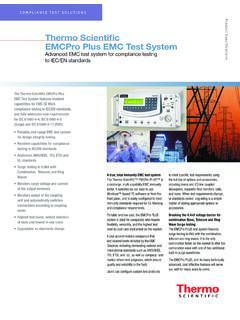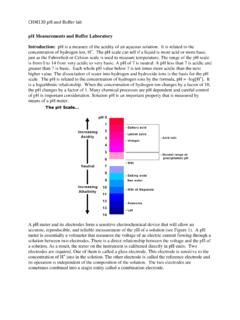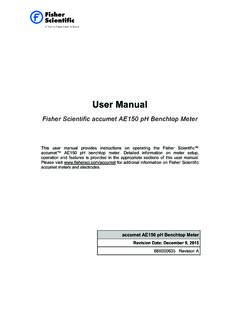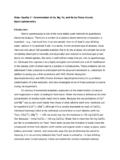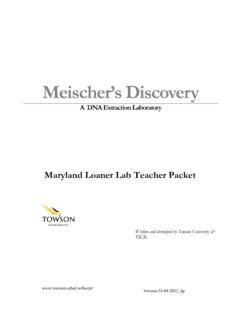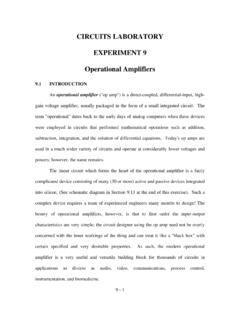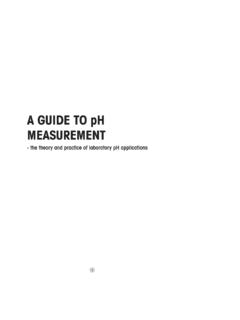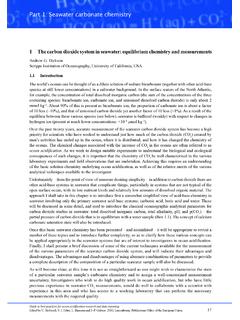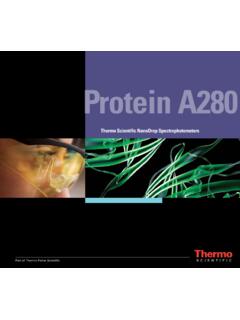Transcription of NanoDrop 2000/2000c Spectrophotometer
1 NanoDrop 2000/2000c Spectrophotometer User Manual The information in this publication is provided for reference only. All information contained in this publication is believed to be correct and complete. Thermo Fisher Scientific shall not be liable for errors contained herein nor for incidental or consequential damages in connection with the furnishing, performance or use of this material. All product specifications, as well as the information contained in this publication, are subject to change without notice. This publication may contain or reference information and products protected by copyrights or patents and does not convey any license under our patent rights, nor the rights of others. We do not assume any liability arising out of any infringements of patents or other rights of third parties. We make no warranty of any kind with regard to this material, including but not limited to the implied warranties of merchantability and fitness for a particular purpose.
2 Customers are ultimately responsible for validation of their systems. 2009 Thermo Fisher Scientific Inc. All rights reserved. No part of this publication may be stored in a retrieval system, transmitted, or reproduced in any way, including but not limited to photocopy, photograph, magnetic or other record, without our prior written permission. For Technical Support, please contact: Thermo Fisher Scientific 3411 Silverside Road Bancroft Building, Suite 100 Wilmington, DE 19810 Telephone: 302-479-7707 Fax: 302-792-7155 E-mail: For International Support, please contact your local distributor. Microsoft, Windows, Windows NT and Excel are either trademarks or registered trademarks of Microsoft Corporation in the United States and/or other countries. Adobe and Acrobat are trademarks of Adobe Systems, Incorporated. All other trademarks are the property of Thermo Fisher Scientific Inc.
3 And its subsidiaries. NanoDrop is a trademark of Thermo Fisher Scientific. Revised 3/09 Table of Contents 1. INSTRUMENT INSTRUMENT SAMPLE RETENTION PEDESTAL Pedestal Basic CUVETTE Cuvette Basic BLANKING AND ABSORBANCE FLUORESCENT 2. COMPUTER SOFTWARE Registering Your SOFTWARE Left Right DATA AND ACCOUNT My Autosave 3. QUICK measurement NUCLEIC Nucleic Acid Unique Screen Making Nucleic Acid Oligo MICRO Dye/Chromophore Unique Screen Making Micro Array 3-9 Oligo Unique Screen Making UV-Vis PROTEIN Unique Screen Making Protein A280 PROTEINS & Dye/Chromophore Unique Screen Making Proteins & Labels PROTEIN Unique Screen Making BCA Assay PROTEIN Unique Screen Making Lowry Assay PROTEIN Unique Screen Making Bradford Assay PROTEIN PIERCE 660 Unique Screen Making Protein Pierce 660 nm Assay CELL Unique Screen Making Cell Cultures APPLICATION 4.
4 METHOD EDITOR METHOD EDITOR Left Right MAKING CUSTOM METHOD 5. SCREEN Data Acquisition CALCULATING A MAKING KINETIC 6. WARRANTY AND Replacement WEEE MAINTENANCE OF THE SAMPLE RETENTION Pedestal MAINTENANCE OF THE CUVETTE MAINTENANCE 7. DIAGNOSTICS AND INTENSITY CALIBRATION Pedestal Calibration Check Cuvette Calibration Connection Power SAMPLE RELATED Sample measurement Accuracy and CONTACT TECHNICAL TROUBLESHOOTING 8. QUICK START SOFTWARE FEATURE CLEANING AND RECONDITIONING Section 1- introduction 1. introduction Instrument Description Thermo Scientific NanoDrop 2000/2000c Spectrophotometers measure 2 ul samples with high accuracy and reproducibility. The NanoDrop 2000c model offers the convenience of both the NanoDrop patented sample retention technology and a traditional cuvette for sample measurements.
5 The sample retention system employs surface tension to hold the sample in place between two optical fibers. This enables the measurement of very highly concentrated samples without the need for dilutions. Using this technology, the full spectrum (190 840 nm) NanoDrop 2000/2000c Spectrophotometers have the capability to measure sample concentration up to 200 times more concentrated than samples measured using the standard cuvette. Instrument Specifications NanoDrop 2000/2000c pedestal mode Instrument Type: Spectrophotometer Minimum Sample Size: L Pathlength: 1 mm (auto-ranging to mm) Light Source: Xenon flash lamp Detector Type: 2048-element linear silicon CCD array Wavelength Range: 190-840 nm Wavelength Accuracy: +1 nm Spectral Resolution: < nm (FWHM @Hg nm) Absorbance Precision: absorbance (1 mm path) Absorbance Accuracy: 2% (at absorbance at 257 nm) Absorbance Range: -300 (10 mm equivalent) Detection limit: 2 ng/ L dsDNA Maximum Concentration: 15,000 ng/ L (dsDNA) measurement Time: < 5 seconds Footprint: 14 cm x 20 cm Weight: kg Sample pedestal Material of Construction.
6 303 stainless steel and quartz fiber Operating Voltage: 12 VDC Operating Power Consumption: 12-18 W, (max 30 W) Software Compatibility: Windows XP and Vista (32 bit) NanoDrop 2000c cuvette mode Beam height: mm Heating: 37 C Stirrer: 150-850 RPM Pathlength: 10, 5, 2, 1 mm Detection Limit: ng/ L dsDNA Maximum Concentration: 750 ng/ L (dsDNA) measurement Time: < 3 seconds Weight: kg All NanoDrop instruments are approved to CE and UL/CSA standards. Patents The sample retention technology used in NanoDrop 2000/2000c Spectrophotometers is covered under US patents 6,628,382 and 6,809,826. Other patents are pending. 1-1 Section 1- introduction Sample Retention Pedestal Measurements A 1 - 2 L sample is pipetted onto a measurement pedestal.
7 A smaller, L volume sample, may be used for concentrated nucleic acid and protein A280 samples. A fiber optic cable (the receiving fiber) is embedded within this pedestal. A second fiber optic cable (the source fiber) is then brought into contact with the liquid sample causing the liquid to bridge the gap between the ends of the two fibers. A pulsed xenon flash lamp provides the light source and a spectrometer utilizing a linear CCD array analyzes the light passing through the sample. The instrument is controlled by PC based software, and the data is stored in workbook files (*.twbk) on the PC. Pedestal Sample Size Requirements Although sample size is not critical, it is essential that a liquid column is formed when using the pedestal option so that the pathlength between the upper and lower measurement pedestals is bridged with sample. The dominant factor determining the surface tension of a droplet is the hydrogen bonding of the lattice of water molecules in solution.
8 Generally, all additives (including protein, DNA, RNA, buffer salts and detergent-like molecules) can reduce the surface tension by interfering with the hydrogen bonding between water molecules. Although 1 L volumes are usually sufficient for most sample measurements, increasing the sample size to 2 L will ensure proper column formation for samples with reduced surface tension. Field experience indicates that the following volumes are sufficient to ensure reproducibility: Aqueous solutions of nucleic acids: 1 L Purified protein: 2 L Bradford, BCA, Lowry or Protein Pierce 660 nm assays: 2 L Microbial cell suspensions: 2 L It is best to use a precision pipettor (0-2 L) with precision tips to ensure that sufficient sample (1-2 L) is delivered. Lower precision pipettors (0-10 L and larger) are not as good at delivering 1 L volumes to the measurement pedestal.
9 If the user is unsure about the sample characteristics or pipettor accuracy, a 2 L sample volume is recommended. Pedestal Basic Use 1. Raise the sampling arm and pipette the sample onto the lower measurement pedestal. 2. Lower the sampling arm and initiate a spectral measurement using the software on the PC. The sample column is automatically drawn between the upper and lower pedestals and the measurement is made. 3. When the measurement is complete, raise the sampling arm and wipe the sample from both the upper and lower pedestals using a dry, lint-free laboratory wipe. Simple wiping prevents sample carryover in subsequent measurements for samples varying by more than 1000 fold in concentration. 1-2 Section 1- introduction Cuvette Measurements The NanoDrop 2000c will accept 10 mm cuvettes up to 48 mm tall. When measuring samples using micro, semi-micro, or ultra-micro cuvettes, we recommend using masked cuvettes.
10 Masked cuvettes ensure that all light hitting the detector has passed through the sample. Unmasked cuvettes can allow light to hit the detector that has not passed through the sample. Expected differences between unmasked plastic cuvettes can lead to significant measurement error, especially at low concentrations. Un-masked Eppendorf Uvette Starna masked micro cuvette When measuring samples with analytical wavelengths in the UV (<340 nm), use cuvettes made of quartz, as these pass UV wavelengths. Although some manufacturers offer "UV-transparent" plastic disposable cuvettes, even the best of these are not transparent at wavelengths below 220 nm; most plastic and glass cuvettes block UV wavelengths entirely. While matched cuvettes have been recommended for single-beam instruments, many cuvette manufacturers have sufficient controls over their manufacturing process to deliver excellent cuvette-to-cuvette performance without requiring matching or certification.
